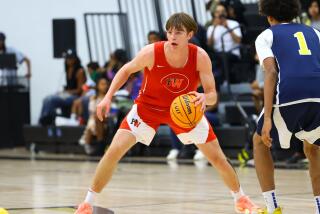Wrestling Center Struggles : Amateur sports: Elite training facility in San Clemente spawned an Olympian, but economy has brought hard times.
SAN CLEMENTE â Eleven years ago, Bob Anderson had an inspiration. At first, it was only a reaction to the moment, but soon it blossomed into a grandiose scheme.
Anderson, a silver-medal-winning freestyle wrestler in the 1979 Pan Am Games, was looking for a place where his son could hone his wrestling skills. Turned away by a full house at the San Clemente Boys Club, he decided to start his own team.
Soon, he was envisioning a wrestling academy to rival anything in Eastern Europe.
Itâs an if-you-build-it-they-will-come sort of story, but thereâs no happy ending in sight. After the humblest of beginnings--how about a dozen kids sharing a Quonset hut on Camp Pendleton for the weekend?--the Jets (short for Junior Elite Training System) became a national powerhouse, winning three consecutive national open championships between 1989 and 1991.
Now, leaning against a weight machine in a sparkling, 11,000-square-foot facility in the hills above San Clemente, Anderson sees his dream fading. Like a relative watching over a terminally ill patient, he keeps up a good front, playfully flopping around the mat with his proteges. But he fears the end is near.
âI havenât had a paycheck in eight months,â he said.
Four years ago, Anderson got together with a nonprofit fund-raising group called Amateur Sports Training Centers and 18 months later ended up with the facility he once could only fantasize about. He quit his job as a nutrition consultant at a number of health clubs and became full-time coach and director. There was enough money to start gymnastics and judo programs, enough to send some of his best wrestlers to compete and train in Europe and the former Soviet Union.
But the economic downturn signaled the end of the good times and now the Jets rarely get out of their hangar. They had no chance at the 1992 national title. Only five wrestlers could afford to pay their own way.
âAs far as funding goes now, they pay the lease and thatâs it,â Anderson said. âWe can keep the doors open for now, but thatâs pretty much it. Weâve tried getting some assistance from the city and the community. Weâve talked to big corporations and small businesses. But there are hundreds of people out there knocking on doors.
âItâs really kind of sad, but it was a lot easier raising money when we were sending a bunch of kids to the Junior Olympics than it is when you have a world-class program and youâre sending a kid (Danny Henderson) to the Olympics.â
Henderson, who will compete in Barcelona in the 180.5-pound class in Greco Roman wrestling, was one of those youngsters in the original group that sweated inside a corrugated steel shed at Camp Pendleton.
âWeâd be there from 5 p.m. Friday to 5 p.m. Sunday,â Henderson said. âWith meals and everything, it cost $8 for the whole weekend. It was kind of like going away to camp for most of us. We thought it was fun because we didnât know any better.â
The way things are going, the bad, old days donât seem so bad.
If the Jets go down and the doors close at their training facility, Anderson and his students wonât be the only ones in mourning.
âThis place has been a godsend for us,â said Mark Calentino, San Clemente High wrestling coach. âYou can work out about 25 people comfortably in our wrestling room and we typically have 45 guys on the frosh-soph team and 35 to 40 on the varsity and JV teams.
âThey let us use this facility so we have the varsity and JV guys work out here. Thereâs a number of other benefits, too. We can separate the two levels, since frosh-soph is basically an introduction to wrestling. And the advanced kids get to work out with world-class athletes.â
Aaron Greco and his family moved to San Clemente from New Jersey a year ago and joined the Jets because a new friend he met in the neighborhood was a member. He won the South Coast League junior varsity championship as a freshman this year.
âThe first time I saw the pools of sweat dripping off Danny (Henderson) after a workout, thatâs when I realized what winning in this sport is all about,â Greco said. âAnd wrestling has really improved my endurance and confidence for other sports like football.â
The relationship between the Jets and San Clemente High was forged years ago when former Triton wrestling Coach John Owens let the Jets use the schoolâs wrestling room in the evenings. Now, Anderson is returning the favor and Calentino wonders why a host of South County schools havenât flocked to the Jetsâ home.
âYou go to the weight room at Saddleback (College) or Capistrano Valley or Dana Hills or Mission Viejo any time of day and itâs packed, but look at this,â he said, sweeping his hand toward the deserted machines and free weights. âAll the local schools could be benefiting from this.â
Since their inception, the Jets have made the most of the money invested in them. After less than a year of Camp Pendleton weekends, four Jets won their weight class in the 13-14-year-old-age group at the 1981 World Championships in Missoula, Mont.
Soon, in a neat little twist of irony, they had broken the Marinesâ stranglehold on the national team championships, winning the open title for three years in a row after the Marines had won five consecutive.
Aspiring young wrestlers came from all over the Southland. Henderson lives in Apple Valley. Others traveled down from Malibu or up from San Diego. For most, the trip was worth it. Jets wrestlers have won more than 50 gold medals in the Junior Olympics and five have won Olympic Festival gold.
For Anderson, who grew up in the South Bay and was the athlete of the year at El Camino College in 1964, it has always been a labor of love. He won his Pan Am medal at age 36 and then retired to concentrate on his second favorite sport: surfing. Always the intense competitor, Anderson won the senior menâs national championship at Huntington Beach in 1980 and 1981.
Now, surfing provides only momentary respite from his problems. Even sliding down a wave, heâs not too far away from the realization that it is all slipping away.
Anderson runs his fingers over a fading picture of a group of youngsters lined up in front of a corrugated steel background. He points to Henderson and then a state high school champ, a Junior Olympic gold medalist, an Olympic Festival winner.
âI donât want to see it end like this,â he says. âIâve worked more than 10 years to get a place like this and now . . .
âThereâs money out there, but itâs not just how good your program is, itâs who you know. And Iâm just another little voice in the wilderness calling out for help.â
Anderson isnât sure how much longer he can hold out, but heâs not giving up.
Heâs going to the mat with this one.
More to Read
Go beyond the scoreboard
Get the latest on L.A.'s teams in the daily Sports Report newsletter.
You may occasionally receive promotional content from the Los Angeles Times.










